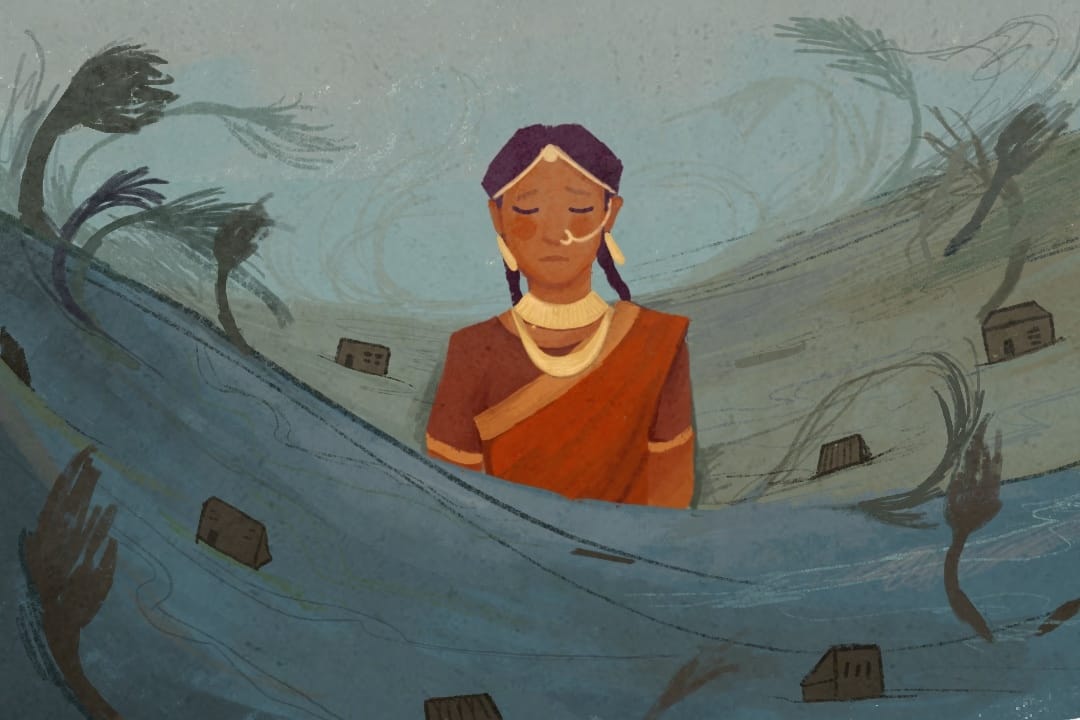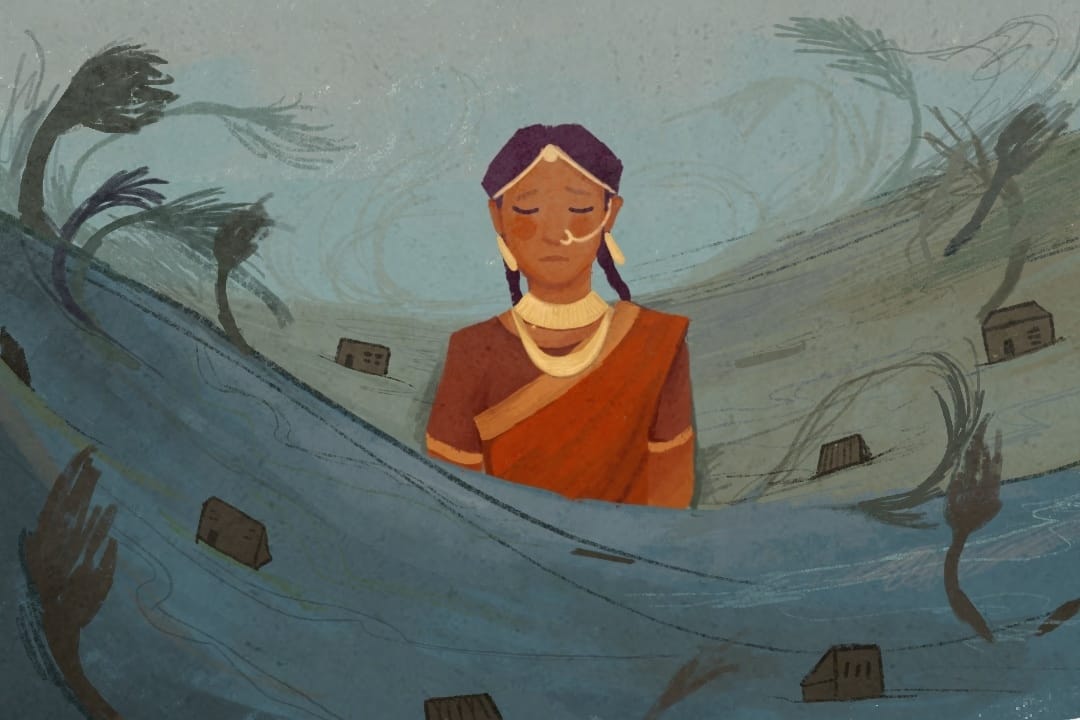
Banner image illustration by Kranti Gadgekar Chhara
Conversation with Reetika Subramanian, who is exploring the links between early marriage and climate change
Child marriage is a crisis in South Asia — almost one in three girls are married by the time they turn 18. Things only get worse when you add climate change to the mix. Severe weather events impact women disproportionately, and early marriage and human trafficking are a few of the ways this manifests. South Asia is no stranger to climate disasters, with deadly floods in Pakistan and the scorching heat wave in the Indian peninsula still lingering in memory. Climate change is expected to displace 62 million South Asian people by 2050.
Currently reporter, Anna Abraham, spoke with Reetika Revathy Subramanian, the founder of the Climate Brides project, who is “untying the knots between climate change and early marriages” in South Asia through her work. Subramanian’s Ph.D. at the University of Cambridge looks into the links between early marriage and drought. A literature review eventually turned into social media posts, and thanks to a grant, the Climate Brides podcast became a reality. Before this, she worked as a journalist, covering labor migration and gender in Western India.
(All discussion paraphrased unless in direct quotes)
Abraham: How is climate change tied to people’s labor and livelihoods? And how does this manifest into early marriage and forced marriage?
Subramanian: Livelihoods have changed quite drastically from agriculture to more labor migration-oriented work. In [drought-stricken] Marathwada, for instance, many are forced to turn from small farmers into sugarcane harvesters. It’s ironic because [water-thirsty] sugarcane is leading to food insecurity, but it is also the only way in which farmers can survive.
Women or girls’ experiences of climate change are linked to daily unpaid labor. They have to walk farther to get water and firewood. Basic everyday work has increased in intensity and [time commitment]. That’s exactly what we’ve been trying to document in the podcast — marriage is an institution of labor.
In the recent episode we did on the climate-vulnerable Sundarbans, professor Upasana Ghosh tells us about women facing trouble gaining [regular] employment in crab-catching. Even if they get work, they are underpaid and work under very extreme circumstances. In turn [they are forced to migrate] making them vulnerable to child trafficking and child marriages.
Marriage becomes a form of climate adaptation.
We’ve been saying these are “marriages of survival”. It’s not like mothers don’t love their children or that they want them to go through this. It is coming from a place of [economic] insecurity. During the pandemic when schools shut down, there were no midday meal schemes [serving free lunch to 120 million Indian school children] available. And in the Sunderbans, there was also a cyclone to deal with. Obviously, you’ll say, “Okay, there’ll be one less mouth to feed — one less burden to attend to if the girl is married off.”
What role do dowries play in these “marriages of survival”?
In some cases it’s dowry and in others, it’s bride price. It’s basically marital payments taking different forms based on their culture. It’s like paying for somebody’s labor. In the episode we did with journalist Ruchi Kumar who was reporting from [drought and violence-stricken] Afghanistan, she talked about the toyna payment system, which is a form of bride price. The potential groom’s family will pay the young bride’s family, not only in cash but also in terms of other resources, like grains. We are talking about brides as young as 12 or 13.
When you have extreme weather calamities, someone more vulnerable would make do with whatever [marital payment] they’re getting. We’ve been observing how people in Maharashtra, India, also give bedding mattresses, air coolers, and even motorbikes, which are useful for [farmers’] climate-induced migration journey.
How are marriage and sex trafficking linked, especially in vulnerable regions like the Sundarbans?
In a region like Sunderbans, which is on the borderlands, you already have existing tension between India and Bangladesh. When you have a cyclone, it increases the existing vulnerability —– whether it is accessing resources, transportation, safety security, and other things. Borders have a very particular and peculiar meaning and political economy. Here, trafficking is not a new phenomenon.
Every year there have been major cyclones, even during the pandemic, and [they] increase the extent of these marital and trafficking transactions. You have young girls getting into this line of work. But these lines are so blurred — whether it’s migration, whether it’s [child] trafficking, whether it is bridal trafficking, or whether it’s marriage, you know?
What role does the caste system in South Asia play in exacerbating these crises?
I think it probably stands at the heart of the problem. Accessing government schemes or any form of support is very much driven by your caste and your social standing. Certain communities do certain jobs, making them more vulnerable to climate change and, in turn, early marriages. It all begins with land ownership. Dalit [outcaste] or Adivasi [Indigenous] households, for instance, wouldn’t have as much access to ownership of land, particularly agricultural land, which makes them more vulnerable and likely to migrate for work during times of scarcity and crisis.
Can you give an example from your research?
Marathwada is a region that has experienced over 25 serious droughts in the last century. Since both the wedding expenses and dowry are taken care of by the girl’s family, a lot of young girls were pushed into marriage during the pandemic and drought period. They said, “There are fewer people to spend money on, we can negotiate the dowry and bring it down.” School closures worsened the situation.
This was more popular among communities like the Banjara community [lower caste] who don’t have much agricultural land of their own, and for whom labor migration is the only way of livelihood. Additionally, labor recruitments in the sugarcane industry [thriving because of drought-induced labor migration] take place in pairs called “Koytachi Judi”, and since with marriage you automatically become an employable unit of two, early marriages increase. From a girl, you can transform her into a wife and a worker. You have the whole logic of the market deciding these factors.

Rural girls struggle to get an education in the drought-affected Beed district in the Marathwada region of Maharashtra, where the practice of child marriage is prevalent | Courtesy: Varsha Deshpande
What are some of the challenges that government policymakers are facing while making meaningful and effective local-level interventions?
One major issue is that we are looking at child marriages as an isolated experience. When the pandemic hit, they were noticing a very high surge in child marriages in Maharashtra. So the district collectorate decided to set up child marriage prevention committees [to promote awareness] at the village level. But the parents already know child marriage is wrong.
Unless you look at it as more of a multi-dimensional problem, you cannot solve it.
Education is one such thing. Children can access free primary education and midday meals till class 8 [in India]. We found that when girls finish school in class 8, they are considered to be marriageable because they cannot access [free food and] the higher secondary school in their own village. They have to travel to the nearby town.
As policymakers, you cannot just say you will increase the age of marriage to 21 for girls and talk about empowerment and equality. You can’t just tell the parents to not get their daughter married, and that they’ll land in jail. We need to start thinking about what households need to ensure they don’t get their daughters married early. We need to extend our thinking to food security, access to education, and access to livelihoods. It’s all interconnected.
Lastly, I’d love to know what’s brewing at the Climate Brides initiative. What can we expect with the next podcast episodes?
I conceive this project as a repository — not necessarily having the most eloquent speakers. We’re trying to interview people who are not necessarily academics, but people actually working in the field. We have done some recordings with researchers from Pakistan about the flood that took place last year, and the subsequent rise in child marriages. This was also the case with the 2010 floods in Pakistan, which caused a surge in child marriages.
Maybe in the next few years, while exploring different platforms, the Climate Brides Initiative can accommodate different language speakers to be on the podcast as well.

